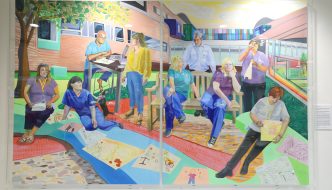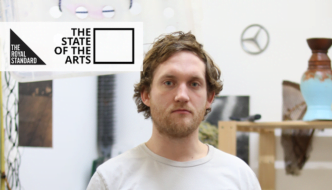
Devon Forrester-Jones: Since your move, CBS has been collaborating with different artist-led organisations much more. How is that going and how has it affected your program?
Theo Vass: It’s been good. Being involved in a dialogue with groups at the same stage as you creates a very beneficial relationship and support network. Now we’re two and a half years old more people are approaching us with ideas. It means we can pick projects we like and broaden our scope. We’re older now and we want to be getting paid for doing events so we are able to pay artists for their work. It’s much more mutually beneficial in that way.
So when the studios help fund the physical space, which includes the gallery as well as the studios, I was wondering how much of an input your studio members have in terms of programming, how much they influence it. What is that relationship?
That relationship is a very organic one. By being a member you have studio space, access to the workshop, and freedom to put shows on. Which means they’re just as involved in the programming. For some people that’s curation, for some people that is facilitating. Jamie Sorensen did his show with Lewdjaw & Karanjit Panesar and Joanna did her show with Gabriella de la Puente. We have a show coming up next month with Lauren Velvick and Nina Chua. And we also have Dan Mahoney curating Nawki. In the last year we’ve represented all of our studio members, in different forms, through the gallery. Our member Mark Simmonds does the graphic design as well. So we work with different studio members on the basis that if they propose and idea we work on it together and bring it to fruition.
With regards to programming, artist-led spaces can easily overlook inclusivity. I was wondering with how you deal with that responsibility at CBS? When artist-led spaces aren’t accountable to a higher body – such as a funder or council – how do you self-manage the responsibility of having a space?
That’s an important question you should ask yourself as an artist-led space, and we do constantly. As the space became more established we kind of realised that we were actually doing this. We had to ask ourselves what our manifesto is and how do we approach being inclusive but also running the space on artistic merit. We ask ourselves ‘How is our program representative?’ . There is very little representation across the art world at large. This position, operating in this world, is hard to work with. Not so long ago we had represented a much higher percentage of male artists to female artists. Since then we’ve had a series of shows that have been mainly women. That’s because there isn’t a bias in our program, it just naturally happened that way. How do you do it in your projects?

It’s not a very structured process. It’s a privilege to have had art education and come out the other side as a practising artist because it’s only really manageable if you come from a certain socio-economic background, which discounts a hell of a lot of people. One strategy I’ve been thinking of is to include other organisations and networks. The best step would be to approach other groups who do it better than us and then offer them the support and space to do whatever thing they might need to do.
Yeah, as CBS we’re recognising more that we’ve got a role in the community. We want to serve our own local community more. But it’s hard when we’re on the second floor and tucked away. We don’t have a relationship with the street and with passers-by. We can’t afford business rates so we can’t have the A1 commercial ground floor place. We’ve got to be tucked away because we’re not money-makers. Community engagement has to be more active. That’s an investment of time.
And that has to be continuous, because otherwise it’s not engagement it’s just a nice gesture. So for self-funded spaces, how do you manage these things which require time-investments while also working full-time?
You just have to find time to fit it in. You have to be passionate about doing it, and if you are you will always find a way to fit it in. You can always find time. As we have this community role we want to see CBS progress and grow, so the question is how do we grow with it? Do we take a structure like The Royal Standard and have a changing directorship, do we apply for Arts Council Funding or other sources of funding which can secure us a paid role? Or do we use the CBS model to create an economy for ourselves. That’s the route we’re trying to go down with CBS Framing. We’re trying a different approach which makes CBS sustainable but also profitable, for our own sanity.
And how’s being in the Baltic [an area of post-industrial Liverpool]?
You are put in the so-called creative sector of Liverpool, which is a nice title the council has given the area. At the moment our engagement with the Baltic has been one which we already had. Being here has been better in terms of accessibility. We’ve had people come from different spaces within the Baltic, so there is an interest there. What it comes down to is get out into the streets and chatting to people, handing out flyers, putting up posters. Old school works. It absolutely works. Seeing someone on the street two days before and talking to them about an event, that personal contact, is much more inviting for people.
And probably does more to make the event stick in their mind. I’ve said I’m interested in countless events which I’ve completely forgotten about once it boils down to the day.
These communities, where you can go and chat to people, are constantly being disrupted though. Crown Building obviously got sold, hence your move, and Gostins on Hanover Street, another place of artistic activity, also recently got sold. It’s sad for the artists, but while we can always find other spaces to inhabit, it’s really sad for small-business owners whose livelihoods depend on these cheap, accessible spaces.
It is sad. Are we just in classic gentrification, or regeneration of certain areas. The most dilapidated buildings always come in and either access it before, or come in afterwards. In Liverpool there isn’t enough grassroots places gentrifying certain areas. There isn’t that structure in Liverpool. The majority of places, for example The Baltic, has had major investment. There was A Foundation there, The Camp and Furnace, but businesses had to match fund through the Council and private funders to make the development happen. It was disused space. There weren’t businesses. Cains and the surrounding area weren’t being at all. Big money moved in before grassroots and regenerated it, rather than the grassroots.

A lot of it is utilising student populations as well. When you think of many of these spaces like The Invisible Wind Factory on the North Dock, the bars and coffee shops in the Baltic, much of it is sustainable because of the younger people who are flocking to Liverpool. As much as I hate to see student accommodation popping up all over the city, the economic benefits of a large student population does have benefits for cultural spaces, which we benefit from as much as developers do.
It comes down to Liverpool being known for its great night life. Concert Square could have been a shopping centre, but the fact it wasn’t gives Liverpool a lot of credibility as a place to go out.
Liverpool is also a walkable city. It helps for those of us on smaller incomes, it helps for cultural events like LightNight and the Biennial.
TV: Definitely. So how do you think Liverpool’s art scene is going to develop?
I’m not sure. It feels very odd right now. I thought I had a firm idea of how Liverpool was, but now I’m not sure. The Royal Standard will always be around, and CBS too. There’s so many smaller spaces too, like Cactus, The Trophy Room, those one-unit gallery spaces. A lot of people seem to be drawn to getting a space and hosting shows, which is great for opportunities for local artists and emerging artists. I think so much of how it develops depends on the students who are coming out of the university right now. They have a lot of energy and their outputs are incredibly varied. I think events rather than exhibitions might be the way it goes, such as workshops, skill-swaps and conversations between artist. I feel like it’s more about supporting other artists and the development of their practice rather than exhibiting. That’s what I’m hoping for anyway, so this is my biased prediction. It’s possible, and it’s what I would like to see. It’s more useful in terms of people understanding their own practices long-term once they’re outside of that educational environment. Even if we have that structure, of events over exhibitions, it could be more inclusive as well, because those without art training are more able to take part. While I would like to see this it does depend on whether people can find spaces and how available people are to engage with those things. What do you predict happening?
TV: Rory Macbeth from the art school engaging with students after university and organising the post-grad residencies at CBS and TRS is incredibly valuable. This year we’ve taken on 5 artists and during their 10 week residency time they have to put on at least one event. Opportunities like this are key aspects to growing the art scene from the university. So we thought we’d support as many of the graduates as we can to keep them in the city.
I also think that the art scene will become so much more multidisciplinary. Right now it feels like there’s clusters of activity, the art scene, the music scene, et cetera. That’s an odd feeling too. So hopefully it will be more multidisciplinary.
TV: It’s going to be great. Having something like applied arts , both in the artist community but also a wider community, having work which can be sculptural or practical, or some intervention. These things have a lot more sustainability than exhibitions that are so short-lived. It helps people think differently.
Well on that optimistic note, I think we can wrap up. Thank you so much for taking the time to chat to me.
TV: No problem, thanks as well.
Theo Vass of CBS talked to Devon Forrester-Jones, a Liverpool based artist. See her website here.
Filed under: Art & Photography
Tagged with: Artist Led Space, Baltic Triangle, CBS< Liverpool, Gnetrification, Studio



Comments